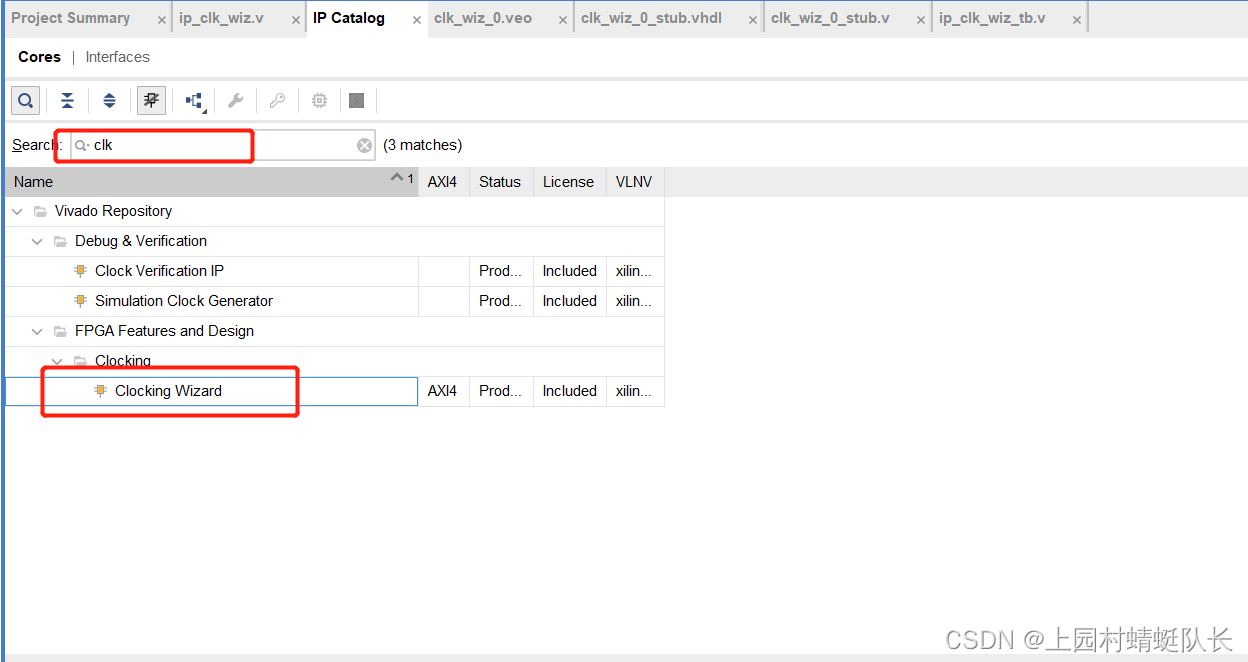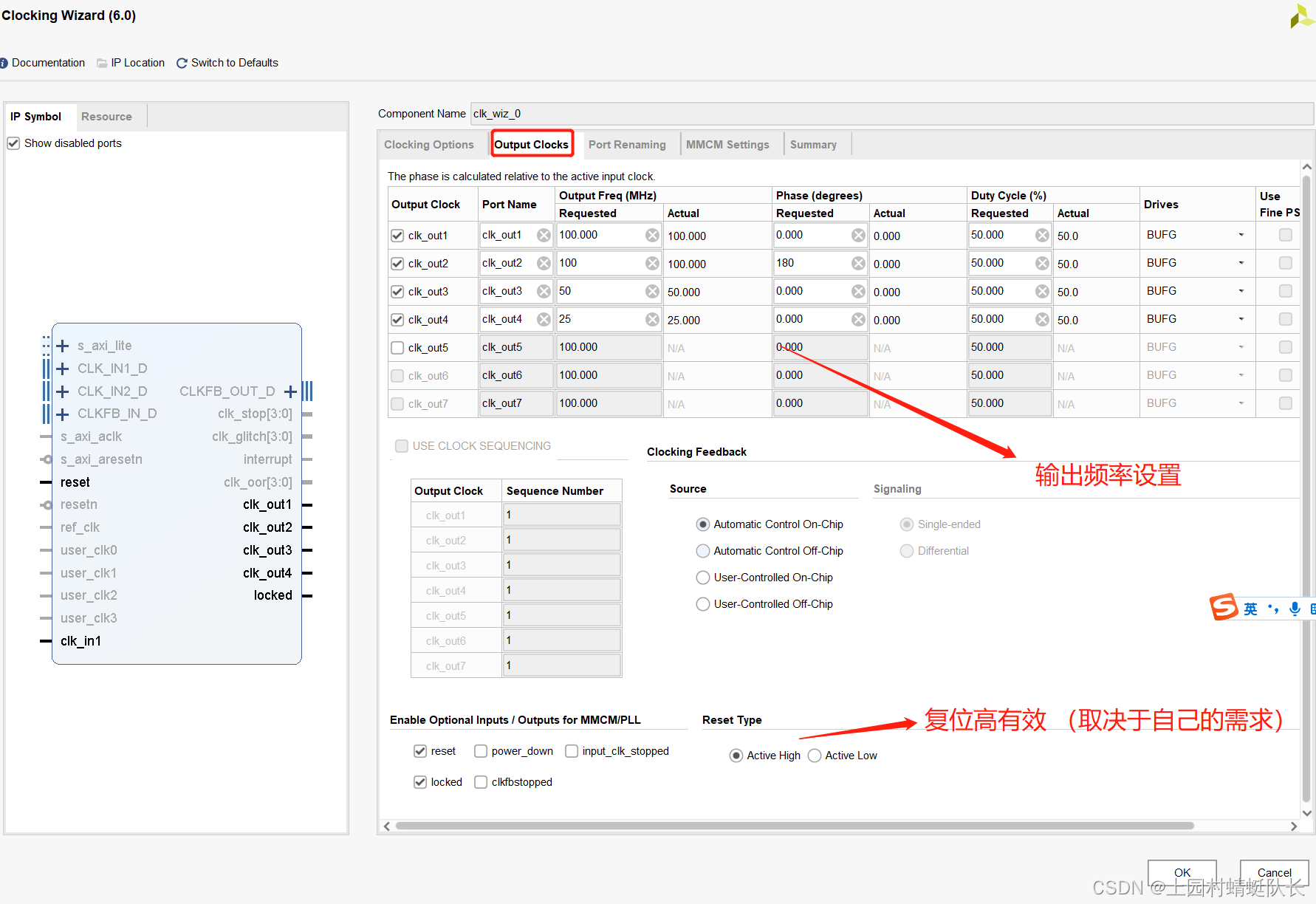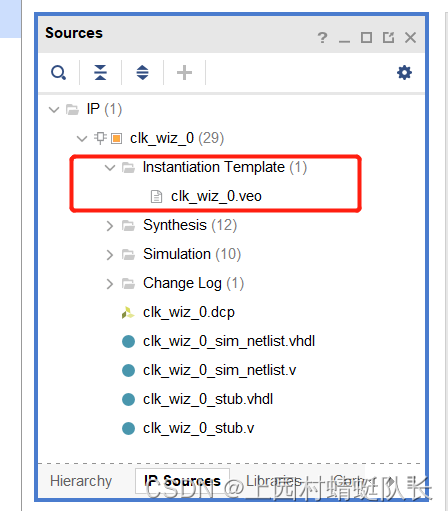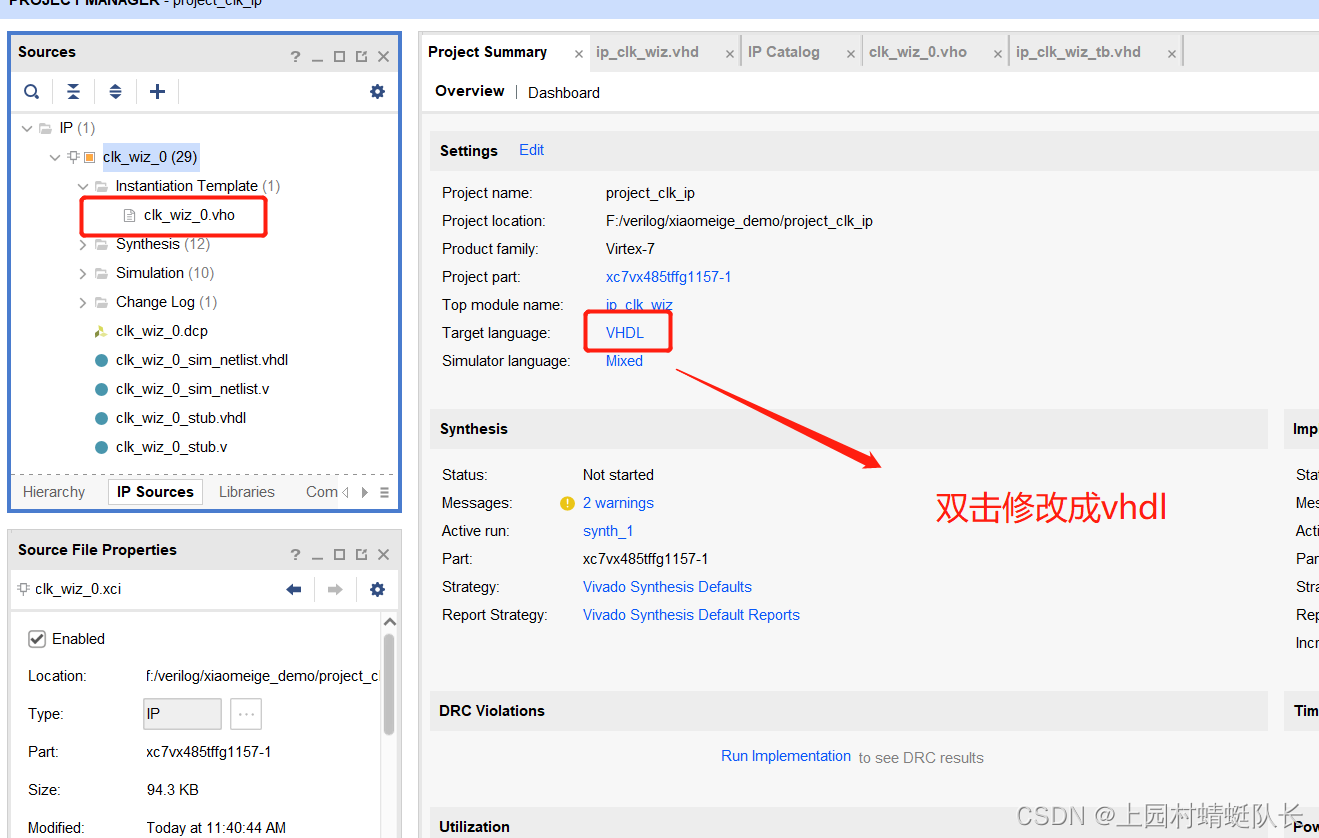????????时钟ip核是一个比较常用的IP核,主要用于对输入的时钟信号进行进行倍频、分频、调整相位。这些功能其实自己去实现也是相对来说比较简单的,但是既然vivado提供了这种封装好的IP核,我们就可以充分的去利用,减少开发者的工作量,而且时钟ip核也有一些比较高级的功能,比如,输出时钟频率和相位的动态调整等等。本篇文章主要记录时钟ip核的基本使用,并附带verilog和vhdl代码及对应的testbench文件,以供同学们相互交流学习。
一、时钟ip简介
? ? ? ? 在介绍时钟管理IP之前,可以先了解一下FPGA全局时钟资源的概念。全局时钟资源是指FPGA内部为实现系统时钟到达FPGA内部各CLB,IOB以及BSRAM等基本逻辑单元的延时和抖动最小化,采用全铜层工艺实现的专用缓冲和驱动结构。
? ? ? ? 全局时钟资源是一种布线资源,在设计中使用的十分普遍。全局时钟资源有多种形式,可以通过vivado的语言模板查看时钟资源的各种原语。
? ?
? ? ? ? 以下就是使用ip核的过程。
二、VIVADO中IP核的设置
1、在ip catalog 中选择时钟ip核。(左侧)

?2、设置ip核

?
三、例化模板
vivado提供了例化模板,包括verilog和vhdl版本。例化模板在ip_source中获取。

?如果是verilog,点开这个veo文件就可以看见例化模板。
如果是VHDL,需要查看项目的target是不是VHDL,这样例化模板才能出现vhdl的vho文件。

Verilog例化ip核
clk_wiz_0 instance_name
(
// Clock out ports
.clk_out1(clk_out1), // output clk_out1
.clk_out2(clk_out2), // output clk_out2
.clk_out3(clk_out3), // output clk_out3
.clk_out4(clk_out4), // output clk_out4
// Status and control signals
.reset(reset), // input reset
.locked(locked), // output locked
// Clock in ports
.clk_in1(clk_in1)); // input clk_in1VHDL例化ip核
component clk_wiz_0
port
(-- Clock in ports
-- Clock out ports
clk_out1 : out std_logic;
clk_out2 : out std_logic;
clk_out3 : out std_logic;
clk_out4 : out std_logic;
-- Status and control signals
reset : in std_logic;
locked : out std_logic;
clk_in1 : in std_logic
);
end component;
-- COMP_TAG_END ------ End COMPONENT Declaration ------------
-- The following code must appear in the VHDL architecture
-- body. Substitute your own instance name and net names.
------------- Begin Cut here for INSTANTIATION Template ----- INST_TAG
your_instance_name : clk_wiz_0
port map (
-- Clock out ports
clk_out1 => clk_out1,
clk_out2 => clk_out2,
clk_out3 => clk_out3,
clk_out4 => clk_out4,
-- Status and control signals
reset => reset,
locked => locked,
-- Clock in ports
clk_in1 => clk_in1
);四、需求分析和代码
需求介绍:
输入50Mhz时钟,产生100M输出,100M输出(180°相位),50M,25M。
verilog 顶层文件
设置好IP核后,verilog工程的顶层文件:
`timescale 1ns / 1ps
module ip_clk_wiz(
input sys_clk,
input sys_rst,
output clk_100m , //100Mhz时钟频率
output clk_100m_180deg, //100Mhz时钟频率,相位偏移180度
output clk_50m , //50Mhz时钟频率
output clk_25m //25Mhz时钟频率
);
wire locked;
clk_wiz_0 clk_wiz_0
(
// Clock out ports
.clk_out1(clk_100m), // output clk_out1
.clk_out2(clk_100m_180deg), // output clk_out2
.clk_out3(clk_50m), // output clk_out3
.clk_out4(clk_25m), // output clk_out4
// Status and control signals
.reset(sys_rst), // input reset
.locked(locked), // output locked
// Clock in ports
.clk_in1(sys_clk)); // input clk_in1
endmodule
verilog testbench文件
`timescale 1ns / 1ps
module ip_clk_wiz_tb(
);
reg sys_clk;
reg sys_rst;
wire clk_100m;
wire clk_100m_180deg;
wire clk_50m;
wire clk_25m;
always #10 sys_clk = ~sys_clk;
initial begin
sys_clk = 1'b0;
sys_rst = 1'b1;
#200//延时200
sys_rst = 1'b0;
end
ip_clk_wiz u_ip_clk_wiz(
.sys_clk (sys_clk ),
.sys_rst (sys_rst ),
.clk_100m (clk_100m ),
.clk_100m_180deg (clk_100m_180deg),
.clk_50m (clk_50m ),
.clk_25m (clk_25m )
);
endmodule
VHDL顶层文件
library IEEE;
use IEEE.STD_LOGIC_1164.ALL;
-- Uncomment the following library declaration if using
-- arithmetic functions with Signed or Unsigned values
--use IEEE.NUMERIC_STD.ALL;
-- Uncomment the following library declaration if instantiating
-- any Xilinx leaf cells in this code.
--library UNISIM;
--use UNISIM.VComponents.all;
entity ip_clk_wiz is
Port ( sys_clk: in std_logic;
sys_rst: in std_logic;
clk_100m: out std_logic;
clk_100m_180: out std_logic;
clk_25m: out std_logic;
clk_50m: out std_logic
);
end ip_clk_wiz;
architecture Behavioral of ip_clk_wiz is
signal locked :std_logic;
component clk_wiz_0
port
(-- Clock in ports
-- Clock out ports
clk_out1 : out std_logic;
clk_out2 : out std_logic;
clk_out3 : out std_logic;
clk_out4 : out std_logic;
-- Status and control signals
reset : in std_logic;
locked : out std_logic;
clk_in1 : in std_logic
);
end component;
begin
-- COMP_TAG_END ------ End COMPONENT Declaration ------------
-- The following code must appear in the VHDL architecture
-- body. Substitute your own instance name and net names.
------------- Begin Cut here for INSTANTIATION Template ----- INST_TAG
i_clk : clk_wiz_0
port map (
-- Clock out ports
clk_out1 => clk_100m,
clk_out2 => clk_100m_180,
clk_out3 => clk_50m,
clk_out4 => clk_25m,
-- Status and control signals
reset => sys_rst,
locked => locked,
-- Clock in ports
clk_in1 => sys_clk
);
end Behavioral;
VHDL-testbench文件
library IEEE;
use IEEE.STD_LOGIC_1164.ALL;
-- Uncomment the following library declaration if using
-- arithmetic functions with Signed or Unsigned values
--use IEEE.NUMERIC_STD.ALL;
-- Uncomment the following library declaration if instantiating
-- any Xilinx leaf cells in this code.
--library UNISIM;
--use UNISIM.VComponents.all;
entity ip_clk_wiz_tb is
-- Port ( );
end ip_clk_wiz_tb;
architecture Behavioral of ip_clk_wiz_tb is
signal sys_clk:std_logic;
signal sys_rst:std_logic;
signal clk_100m:std_logic;
signal clk_50m:std_logic;
signal clk_100m_180:std_logic;
signal clk_25m:std_logic;
component ip_clk_wiz
Port ( sys_clk: in std_logic;
sys_rst: in std_logic;
clk_100m: out std_logic;
clk_100m_180: out std_logic;
clk_25m: out std_logic;
clk_50m: out std_logic
);
end component;
begin
i1:ip_clk_wiz
port map(
sys_clk => sys_clk,
sys_rst => sys_rst,
clk_100m => clk_100m,
clk_100m_180 => clk_100m_180,
clk_25m => clk_25m,
clk_50m => clk_50m
);
init : process
begin
wait for 10 ns;
sys_clk<='0';
wait for 10 ns; --- 和ip输入保持一致
sys_clk<='1';
end process init;
always : process
-- optional sensitivity list
-- ( )
-- variable declarations
begin
-- code executes for every event on sensitivity list
--- sys_clk <= '0';
sys_rst <= '1';
wait for 201 ns;
sys_rst <= '0';
wait;
end process always;
end Behavioral;
仿真结果:

????????由此图可以看出,完全符合我们的输出要求。
